Well, now that I’ve started moving further west, I guess it’s time for me to tell you about my life for 2 months at Bodhi Farms (or is it Farm? There’s only one farm, so why are they plural? Who knows.). Here’s what my life was like from March to May.
The farm
Bodhi Farm (named after a dog, rather than anything particularly Buddhist) is located in Las Vegas, New Mexico, about an hour east of Santa Fe. Brian and Roxane bought and moved to the property 12 years ago from southern California. It’s about 20 acres, with about three quarters of the land a wooded hill, which is purposely left alone in order to support healthy forest and to maintain a buffer between predators and the flock of 200 tasty chickens that are kept on the farm. The property came with a very deep well, which was one of the reasons Brian selected this property, in addition to its 1-hour proximity to Santa Fe. Over the past decade, they’ve done a lot of work regenerating the land and soil through crop rotation, rotational chicken grazing (using chicken tractors), landscaping (building berms, mulching, etc.) to manage the flow of rainwater., and other techniques
They have five greenhouses of various sizes and fanciness, reflecting Brian’s journey learning about different types of greenhouses and eventually transitioning from buying them pre-made to building his own. The five are named: Ryon, Battery, White, Blue, and Red. (Two of them have smart climate-control features built in, with Battery (short for climate battery) particularly neat. Battery has an air intake inside at the very apex of the roof. When the greenhouse heats up during the day, hot air rises to the top and gets sucked down into pipes running under ground. That heats the earth, which retains the heat to help maintain a consistent temperature during the cold nights. Battery is where they keep all their most sensitive plants: starts and microgreens.
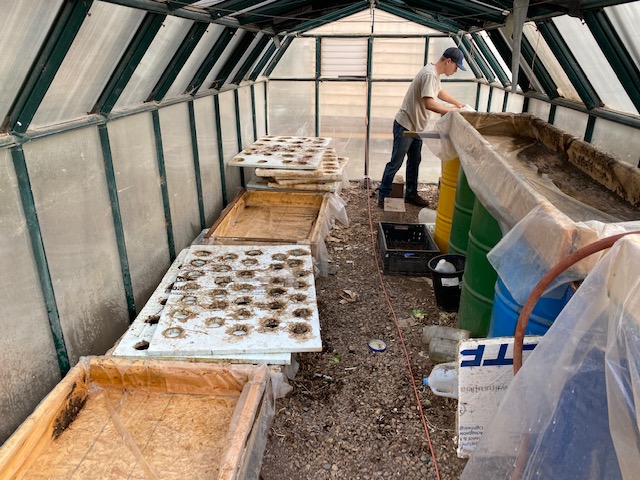
The Ryon 
Perennial arugula growing in Blue
Brian is a tinkerer, an innovator, and an engineer (I use that term colloquially – he studied political science in college), and there are artifacts of his habit all over the farm. This includes plenty of debris and leftover pieces of materials and upcycled supplies from unfinished projects, broken down infrastructure, and soon-to-be efforts. Sure, some of it could be tidier, but overall, I appreciated the implication beneath it all: this is a farm where we make things, do things, reduce/reuse/recycle, experiment, and create. Brian isn’t really one for presentation anyway. Who cares?
The farm is full of clever innovations and projects. Besides the climate battery stuff, the most visible agricultural innovations that Brian uses are vertical grow towers and hydroponics. Both are in service of resource efficiency for growing food.
Grow towers
Brian uses (and reuses and reuses) styrofoam containers that he bought a very long time ago to construct towers. Towers help maximize the space that gets used for growing. (And, in Brian’s words, they’re nice for old people because you don’t need to bend over as much.) They are rectangular, and when stacked 5 or 6 high, they allow you to grow a plant out of each corner. The towers are watered from the top, and water just percolates down through to the bottom. Because most of the soil surface area is covered by the container above it, there’s limited evaporation. Towers are lined up every 3 feet down an 80-foot row, and a drip line is run across the top of the whole row. Every couple days, he turns on the drip line for a few hours, and you’ve got yourself some very happy plants. In my time there, most towers had some form of lettuce, although a few had peas and nasturtiums.

To further optimize usage of space, there are pots placed on the ground between each tower, which catch water dripping from the drip lines. We had potatoes in these pots. And finally, to even further optimize the space, we planted chard directly in the ground between each of those pots! That soil gets plenty of water from above, so why not use it?

Hydroponics
Brian uses two variations on the Kratky method for hydroponic growing. Generally speaking, the Kratky method lays out a way to grow plants directly in pH- and nutrient-optimized water. It’s a really efficient use of water and resources, and there are a lot of plants that thrive in it. The standard Kratky approach is just a tub of standing water covered with a lid (his are styrofoam) with holes in it for plants. The water is completely closed off, which limits evaporation and also the lack of sunlight to the water keeps things from growing in it. Hydroponic baskets and plastic solo cups with holes in them (upcycling!) are filled with soil and placed in the holes. We then plant things in the cups, and the roots grow down into the water, and they’re very happy. Brian also has a bunch of 5-gallon buckets that he uses for more Kratky growing – he just cut a few holes in the lids, and good to go.
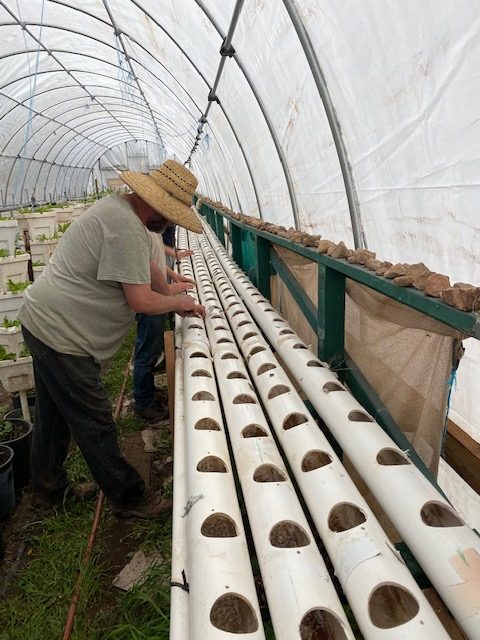
The other Kratky variation he uses is something he made up that he calls the “hydro.” Instead of plants growing in standing water, they receive running water for 1 minute every hour. It’s a long 6-inch PVC pipe with holes cut in it for the plants, and the pipe is on a very slight incline. It has a water reservoir at the end and a pump that turns on once an hour and pumps water to the top of the pipe, allowing it to flow down through all the growing plants. Compared to the standing-water method, this allows him to more-easily monitor nutrient levels in the water by simply checking the reservoir. I’m also guessing that this method may use slightly less water per plant, although I’m not positive.
The farmer
Brian is a really interesting, fun, and knowledgeable guy; and frankly, he was a large part of why I stayed there for so long. Not long into my stay, I could just tell we vibed really well. Brian was raised in the Midwest (farm country) and went to college in southern California, the first in his family to go to college. He ended up in the tech world and even founded an ecommerce company in the 90s and made a well-timed exit before the dotcom bubble burst. About 10 years ago, they decided they needed to get out of LA, and so they looked around and settled on this property. As Brian tells it, he got into farming because the problems were interesting. He’d decided that the rules for building a business and running a startup are pretty straightforward, and the problems that need solving in that world began to bore him. But sustainable agriculture offered plenty of space for him to play and innovate. Since he got into this space, he’s built a lot, innovated a lot, failed a lot, and learned a lot. In one of our several engaging conversations (in which he treats me as a friend and a peer – for which I’m grateful and humbled), he shared with me that he has an ambition to share his discoveries, innovations, and methods with the world. He feels he’s getting close with several of his techniques to them being reliable enough to share, but not quite yet. That said, he does feel like his technique for growing microgreens has been perfected, and is ready for the world! Well, getting it out there is quite another matter. I suggested putting a zine together, and offered to help. I never really got moving on that effort myself, so I do understand how hard it can be to get moving on this sort of this.
I really respect Brian a lot and just enjoyed spending time with him, and I’m grateful for the respect he gave me in my time there. I think of Brian as a friend and maybe even a mentor, and I hope to see him again (and certainly to stay in touch).
The work
We started every day around 9am by drawing daily chores: feed/water the animals, collect eggs, package eggs, sweep the common areas, wipe counters, water the plants in Battery, take out compost, and water pea shoots (when there are any to water). I think my favorite was probably feeding and watering the animals, but I enjoyed collecting eggs too. Collecting eggs was a much bigger undertaking at Bodhi than at LowGear, where we were getting maybe 8-10 eggs per day (although I understand this went up in the spring). At Bodhi, we need to collect twice a day, because if the eggs are allowed to accumulate throughout the day, the hens will start laying in piles and sitting on them, and eggs will start to get broken. We would collect over 100 eggs per day.
After chores, we would all get to work on whatever projects Brian had prioritized. Fridays are always harvest day, where we harvest all the stuff he’s going to bring to the Santa Fe Farmers’ Market on Saturday, including microgreens every week. Other days, we would be planting microgreens (a process that he’s all but perfected, yielding him lots of microgreens that he brings to market every week), weeding, building grow towers, refreshing Kratky beds, seeding starts (most plants are started in the greenhouse, before being transplanted into their final homes), transplanting starts (we did lots of lettuces, tomatoes, and scallions), and whatever other random things needed doing.
Brian was pretty good about limiting our work to 4 or 5 hours a day, with an occasional day being even shorter.
Accommodations
I stayed in what Brian calls the Isopod, which is a structure that Brian built shaped sort of like a 10-sided die. It has a loft with a bed in it, and plenty of living space downstairs. I peed outside and had to use the house for other needs, but it was nice to have a separate space outside the house, because the house could feel a bit cramped at times with the other WWOOFers and Brian and Roxane. There are two bedrooms in the house for WWOOFers to stay, and there’s a camper outside as well as a tiny A-frame hut that still needs some finishing touches before someone would want to stay in it.
Free time
In my spare time, I puttered a good amount. Eating, tidying, cooking, and hanging out with the animals. While some of my fellow WWOOFers tried to stay very active, going out to hike or explore on several afternoons during the week and every weekend, I took a more measured approach and tried to just live comfortably and contently. I’ve traveled a good amount in my life, and I’ve very acutely felt that feeling of “gotta see it all, must not waste a moment.” In fact, there were times when I would see others in the hostel just hanging out all day at the hostel. I remember thinking that they were just wasting their time. Well, now I’ve become that time waster. There’s always going to be something you didn’t see or do. And so you need to keep in mind your own values. Is “see it all” really one of my values? One of my priorities? Not right now, no. Perhaps part of it is that my wander is not a vacation, but rather my life, so there’s less of a feeling of urgency. (Even as I write this, I am sitting at a campsite in the San Juan National Forest, having decided to just enjoy this site all day, rather than my original plan of rushing to go for a hike.)

As a result, I settled into a routine and a life. I took on small tasks around the farm that I thought needed doing. For instance, after we’d moved 30 chickens into a new pen (which had already had 25 in it), I grabbed the electric driver and put together some nesting boxes for the chickens. I used a pickaxe to level a walkway after my cart had tipped over for the third time. I built a simple system with a solar light to help Brian see from a distance whether the chicken coop had been closed for the night. I attached padding to the top of the the door of my cabin, because I kept smacking my head against it. I found and baked an awesome sourdough recipe that comes our great at high altitude. I read, watched movies, snacked, played with the goat; whatever I wanted without feeling the urgency of going somewhere or getting something done.
Yes, I did leave the farm a couple of times. Two big trips I took were to Taos for skiing, and to northwest New Mexico for a long birthday weekend. On that birthday weekend, I visited the incredible Bisti Badlands/De-Na-Zin and Ah-Shi-Sle-Pah Wildernesses, as well as Chaco Canyon National Park. I could probably write a whole blog post about these places, but I’ll just let the photos do the talking.

Rio Grande near Taos 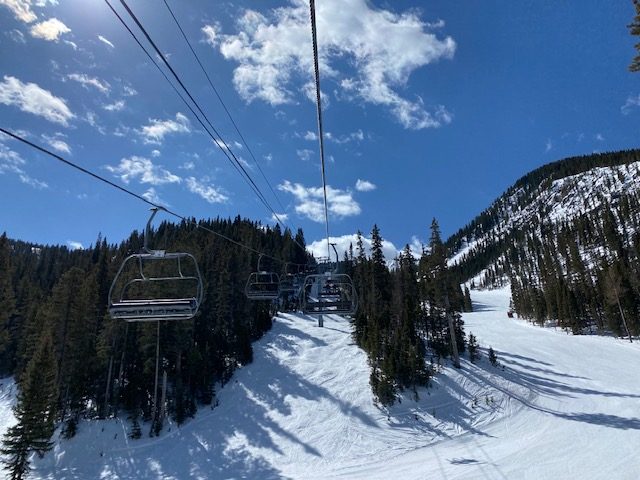
Taos skiing 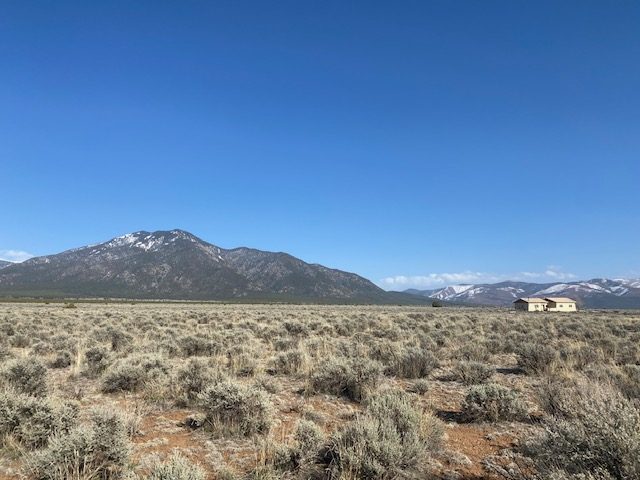
Taos views 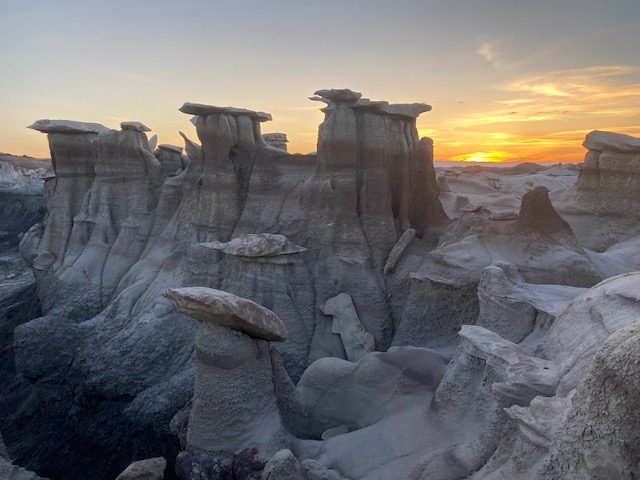
Bisti Badlands/De-Na-Zin 
Ah-Shi-Sle-Pah Wilderness

The most formidable (and frustratingly unrealized) project I took on was the construction of a meditation platform up on the wooded hill. Early in my time at Bodhi, I realized that there really weren’t many places to relax and hang out, other than their dimly-lit living room. Having participated in the construction of a meditation platform at Rainwater Collective, I shamelessly borrowed Rachel’s plans and designed a platform for Bodhi. I ran the idea by Brian, and he loved it. I ran it by fellow WWOOFers Toby and Aislinn, and they were keen as well. Well, the keenness never truly faded, but getting something like this done takes a lot more than keenness. Each step took time and patience. I wouldn’t say that Brian dragged his feet on getting this done, but he usually had plenty of other things on his plate, and so he never really had a chance to dive in with the energy that would’ve allowed this to get done during the length of my stay (which I extended a few times). Each step of the way, there were practical delays (e.g., the chainsaw needs a new chain before we can use it), unforeseen delays (e.g., the guy at the store sold Brian the wrong chain), and motivational delays (e.g., it took Brian a while to get around buying a chain). And with the various steps and associated delays adding up (e.g., procuring chainsaw chain, procuring drawknife, procuring dimensional lumber, procuring bolts, etc.), I never got to see much progress made, beyond felling the necessary trees, and debarking a few of them. I’ve sent Brian my plans, and I hope that one day, this dream will become a reality.
Market

Attending the Santa Fe Farmers’ Market with Brian was one of the highlights of my time at Bodhi Farms. Santa Fe is a very large market for the area (moderately-sized, compared to some NYC markets, of course), and it attracts locals and tourists alike. WWOOFers have weekends off, but on my very first Saturday at the farm, I opted to join Brian at the market. Brian gets to the market (which is an hour away) by 7:30am, because although the market opens at 8am, there are always people there early (Santa Fe is full of old people). I let myself sleep in, and I met Brian at the market around 9am. Once there, I got to work selling eggs and greens, chatting people up, and welcoming tourists. I even chatted with other vendors and organizers of the market. Brian is a pretty great farmer, but he doesn’t enjoy the sales process as much. I, on the other hand, really enjoy that process. I think a big part of it is that having something to offer people gives me a reason to talk to strangers, which is otherwise pretty intimidating for me when I don’t have something explicit to offer them. So I think we make a great team. At my first market, I had a couple great conversations with some young Santa Feans, and I was hooked. Over the next couple months, I think I went to 4 or 5 markets. If were to have stayed in the area on a more permanent basis, I’m confident I would’ve made some very cool friends through that market.
Animals
It’s become clear to me that I really like animals. In fact, I always did. I remember as a child being extremely rapt by my nature magazines (e.g., Ranger Rick, NatGeo Kids, etc.) and nature shows (Jack Hanna, Kratts’ Creatures, etc.). Despite not really growing up with any animals, I knew a lot about them and loved them. Well, all evidence points to that still being very much the case. I would regularly spend my free time on the farm watching the animals, playing with them, or caring for them in some way. My favorite morning chore was feeding and watering the animals, and my favorite part of my afternoon was letting the chickens out of their pen.
Cats
Officially, they have one cat, named Gizmo. She gets to live indoors, but she likes to hang out outside too. They also feed several feral/neighborhood cats. I probably counted 6 or 7 throughout my time there, but there may be even more. My favorite was Orangey (creative naming is not one of Brian’s passions), a big tomcat who was probably orphaned and so never learned to groom himself.
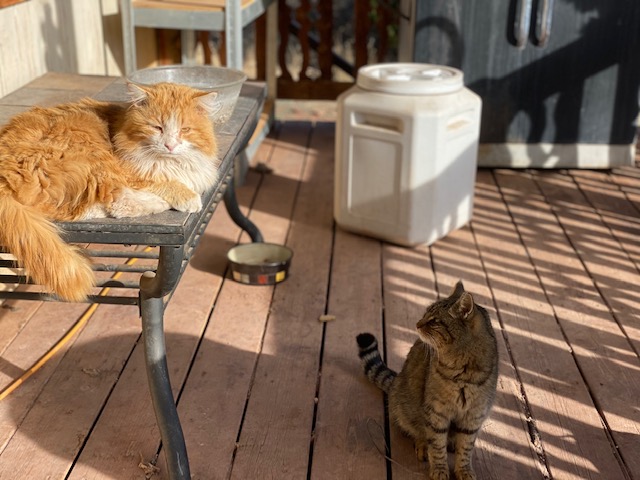
Orangey and another cat 
Gizmo being a creep
Dogs

Baldur the Tibetan mastiff 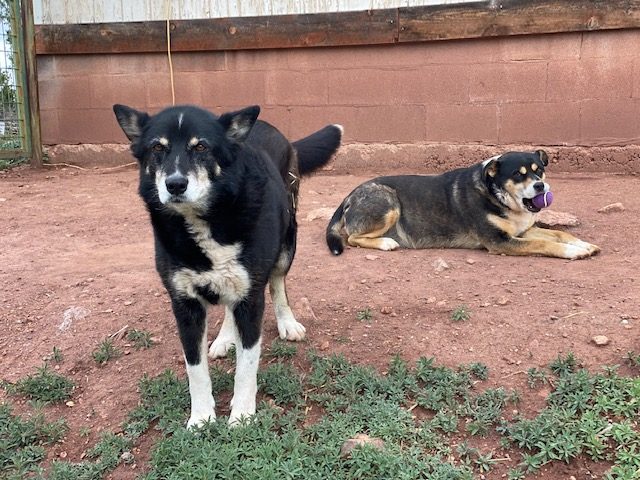
Orpheus and Molly
There are three dogs, Baldur, Orpheus, and Molly, who mostly live outside, although they are occasionally allowed indoors, when the cat has been safely secured. I typically like dogs, and these ones were fine, but they are almost completely untrained (as far as I could tell, none of them even responded to their own names), and this annoyed me to no end. I guess unlike with cats, I expect to be able to have some sort of communication and understanding with a dog, and I just found it frustrating to not be able to have that with these ones. That said, they did enjoy getting petted, so no complaints there. Well, I guess my one complaint was that they were all shedding a lot, probably due to the season. So petting them meant getting a hand full of fur. I didn’t spend a ton of time with the dogs.
Goats
There are two goats, who are simply pets. They’re Alpine breeds, which means they’re quite a bit larger than the ones at LowGear. At one point, there were more goats, and I think Brian wanted to do some milking, but he dropped that idea and got rid of all but two. These two are siblings and, by Brian’s naming convention, are of course named Boy Goat and Girl Goat. Toby and Aislinn, bless them, decided to name them Walter and Margaret, which I hope sticks. Margaret is the most flighty thing I’ve ever seen. If you get closer to her than maybe 15 feet, she will stop whatever she’s doing and literally flee in the other direction. I don’t get it, but she can’t be reasoned with.
Walter, on the other hand, is a goofy goat, but he’s very sweet once you learn his idiosyncrasies. Like his sister, he also has issues with personal space, but only sort of. He’s perfectly fine with me standing 3 feet away and stretching my arm uncomfortably far out to pet him. But the second I take a step closer, he backs away or even runs. But he’s very content to receive neck and face scratches, and he also enjoys playing! The rules of the game are unclear, but it seems to involve him putting his head down the way when he and his sister butt heads, and then I push on his head, and he enjoys that. Sometimes he’ll back up and rear up a bit. It’s good fun, although I admit it was a touch scary when that big fella would rear up!
Ducks
A few days into my stay, Brian informed us that he was to be receiving a surprise delivery of 7 ducks, and we needed to quickly build an enclosure. We quickly put on some fencing, and 6 females and 1 male duck moved in later that day. They’re very cute and lots of fun to watch, what with their quacks and butt wiggles. They have a tiny pool (ducks need a pond-type of area), which we dump and refill once or twice a week. Whenever the water gets dumped, the ducks have a real party digging through the mud and getting filthy. They promptly clean themselves off in their newly-filled pool. Just ducks being ducks. They seem to lay between 3 and 7 eggs a day, which Brian sells at market.
Chickens
I really fell in love with these things. There are about 200 chickens, divided between 2 pens (previously 3 pens, but we consolidated in order to make room for some new meat birds that Brian plans to buy). I loved feeding them, watering them, collecting their eggs, and just watching them. They’re clever in some ways, adorably stupid in others, fascinating to watch, soft and sweet to hold (when you can catch them; Brian told me I was the second-best chicken catcher they’ve ever had! Key is not to be afraid of them.). The biggest negative (and it was a pretty big one, considering the proximity of my cabin to the pen) was that the roosters make a hell of a racket starting very early in the morning (often around 4am).
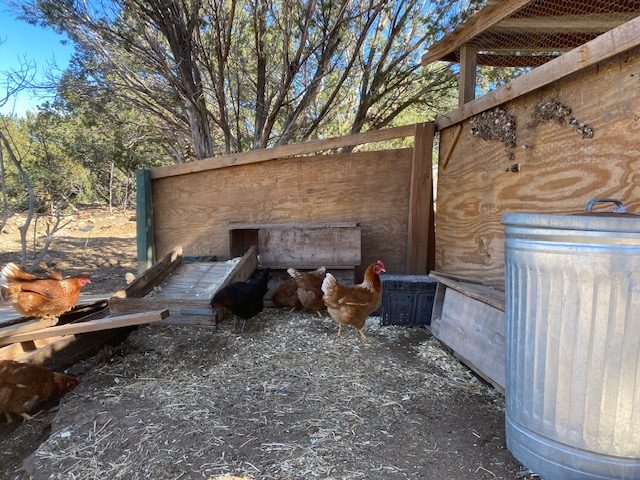
Nesting boxes I threw together 
This is a chicken pancake covered in flour 
Some sleep in trees! 
Nap time 
An escape artist 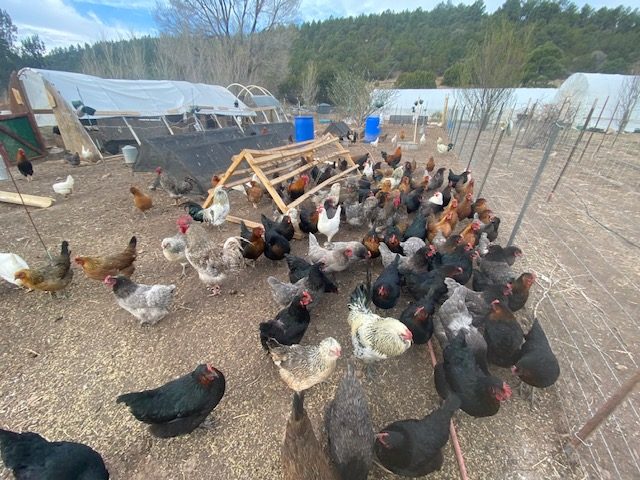
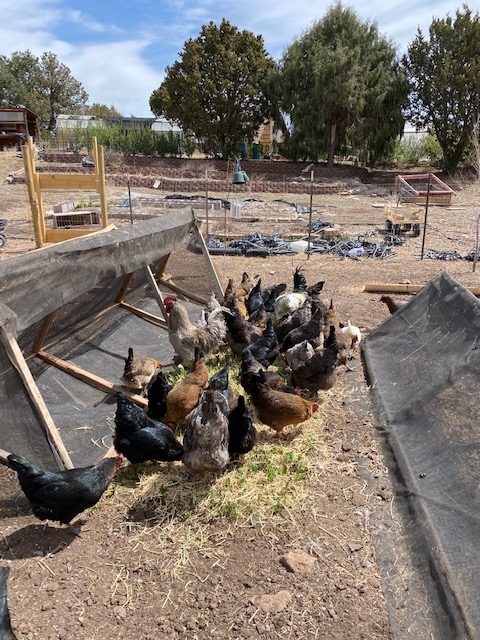
Eating fresh greens we’d been protecting from them for a while 
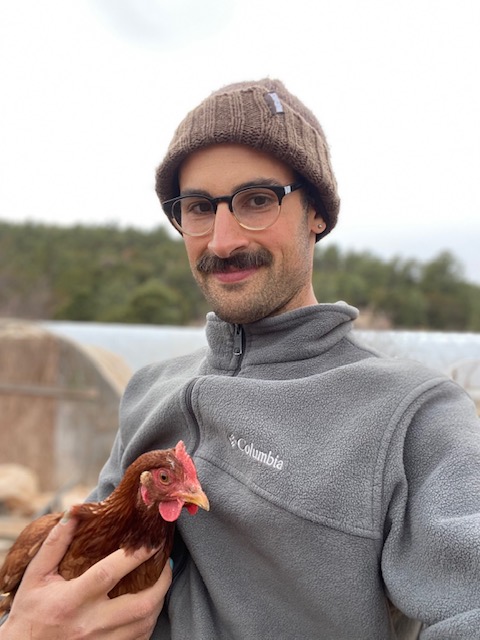
Frieeeends
Eggs
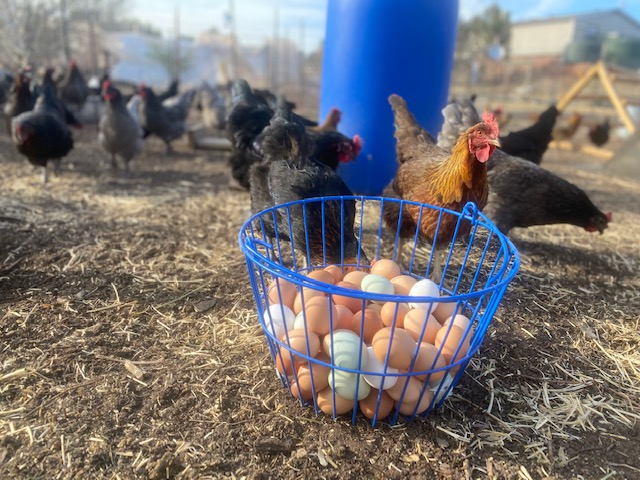
Between the 200 or so hens, around 120 eggs are laid each day in the spring (when they lay the most). Eggs get collected at least twice a day, because there are only a few spots where they lay the eggs, and if the morning eggs aren’t removed, then they could get crushed and broken. They come in several colors, including white, blue, light brown, and dark brown. The color just depends on the breed of chicken laying it, and they all taste/look the same inside. (Americanas lay the blue ones, in case you’re wondering.)
Collecting eggs is generally pleasant, except for the fact that some of their nesting locations are in tight spaces that are awkward for a human to crawl into. When collecting, things can get entertaining (or possibly upsetting, if you’re the chicken) when trying to extract eggs from underneath the birds. In a given nesting area, there’s almost always a hen sitting on a clutch of eggs, most of which are not her own. Most hens either don’t mind if you just reach under them and pull out those warm eggs, or they get up and leave. But there are a couple breeds of hens that are particularly broody, which means that they are instinctually obligated to sit on those eggs come hell, highwater, or human hand. As you get close to them, they start screaming like dinosaurs, and then they start pecking at you (wearing gloves helps), and the solution in most cases is either to just shove them aside or lift them up and move them. Perhaps its cruel to make light of what may be upsetting to the bird, but I just find this process funny and entertaining to do. It just feels like they’re making the same fuss every day, knowing full well how this works.
These animals are pretty driven by instinct, but I sense that they are pretty quick learners too. For instance, the birds in one pen have learned the routine that they get let out every afternoon after 4pm to wander the farm and forage. They love it, and I love letting them out. As a result, anytime they see me(or someone, I presume) anywhere near the pen after about 2pm they all rush toward the gate and wait patiently to be let out. It’s often a false alarm, because it they’re let out before 2pm, then some of them may still have eggs to lay, and they’ll lay them somewhere the eggs will never be found. (This is why they were put in a pen in the first place. Until last year, they were completely free range, but they would lay eggs all over the place, making them hard to find.)
Another funny habit a couple hens have learned is nesting in a cardboard box in a shed. There are 2 or 3 hens who are always in this box, brooding and hanging out. If you grab one and put her back in the pen, she will almost immediately hop the fence and go directly back to the box. (Only a few hens have figured out how to escape; I suppose having a nesting location outside the pen is a powerful motivator for the would-be escape artists. Another hen always manages to escape into the duck’s pen so that she can eat their food… which is the same as the chicken food.)
Another fun one is the way chickens react to running water. They come from all over to peck at the wet ground.
Slaughter
I had the privilege of first witnessing and then taking part in the process of slaughtering several chickens on two separate occasions. This is an important topic that’s important to not gloss over, and I also have thoughts and reflections that I’d like to share. So I’m going to write this up separately and will post it when it’s ready.
Other WWOOF guests
In my 2 months, I shared time and space with 8 other WWOOFers. I clicked with some people more than others, but I must say that it was generally pleasant to have others around the farm, besides Brian. With one exception, I was quite a bit older than everyone else (most ranged from 18 to 24 or so), which felt like it contributed to a bit of a barrier in forming deep connections. (Compare to Anthony, for example, who was about my age.)

Nonetheless, I was quite fond of Toby and Aislinn, a couple of recent college graduates who decided to spend some time in the southwest, rather than languishing at home on the East Coast. Together, they were simply a hilarious pair who also seemed to have a good rhythm together. They regularly cooked food for everyone, led the charge in hanging out, and they had an impressive determination to frequently leave the farm to go for a hike or an exploration. Toby and I had a few opportunities to connect one-on-one, where I witnessed his ability to be delightfully open, honest, and vulnerable. And furthermore, Toby regularly exhibited such charming curiosity in those around him, as evidenced by his thoughtful questions and empathetic responses to those around him. And he just cracked me up on the regular. What a lovely young man, and I look forward to our paths crossing again one day.
I was also glad to have formed a connection with Ryan, who arrived in the last couple weeks of my stay. Ryan is a very quiet guy from South Carolina who is on a bit of his own wander. He likes the outdoors and generally keeps to himself; and he one day revealed that he was into stoicism, which came as no surprise to me whatsoever. As I got to know Ryan a little and dangled the idea of meditation to him, I sensed a spiritual yearning (or at least curiosity) in him, and I was absolutely thrilled when he accepted my suggestion that he read my copy of Jon Kabat-Zinn’s “Wherever You Go There You Are.” Over the next two weeks, Ryan ate that book up and gladly told me how much it was speaking to him. I was quietly overjoyed. I have gifted so many books and suggested so much reading throughout my wander, but I suspect that this may be the first time someone has taken up my intended gift with such gusto. To add to my joy, Ryan gave me the true honor of guiding him in a meditation, which he had never done before. We sat outside under a tree on couch cushions, facing nature, and I invited him to be aware of his body, his breath, and his surroundings. Afterwards, he quietly told me he enjoyed it. We then went inside to continue baking bread (he’d also honored me by asking me to show him how to make bread!). As with Toby, I very much look forward to crossing paths with Ryan once more.
What a time at Bodhi Farm. I recall how, before I arrived, I was planning to stay only 2 weeks. I ended up staying 2 months. Before I went in, I was cognizant that this experience probably wouldn’t meet my spiritual, activism, or “life’s purpose” needs; but I expected to learn a lot about farming and get some great experience. Well I certainly got that experience, but I never expected to feel as settled and comfortable as I did. It was a nice respite from my regular wandering, and it certainly made moving onwards feel strange, if not challenging. But onwards I must go. Wander on.


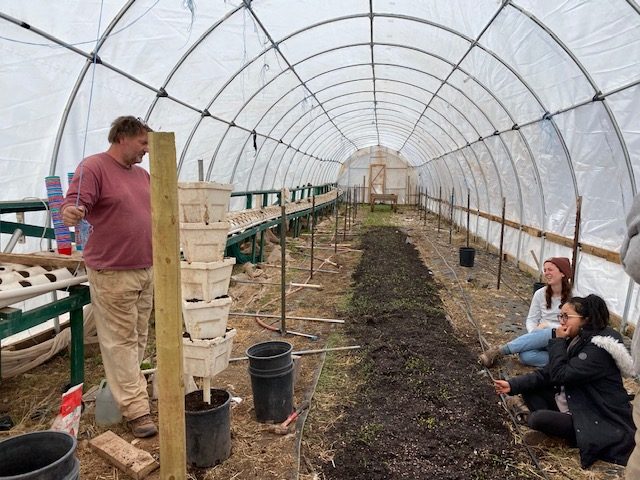
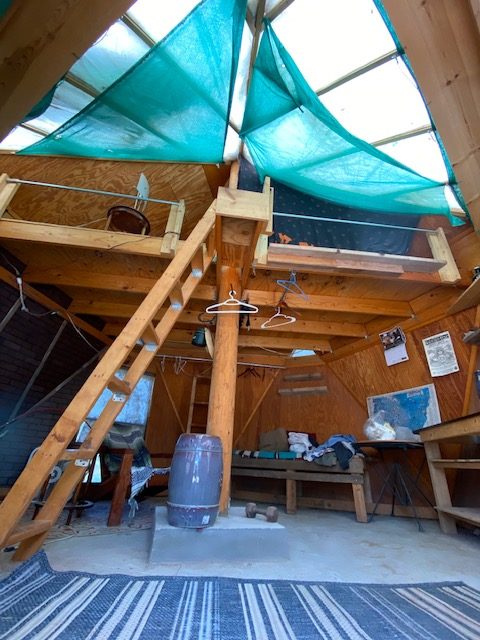
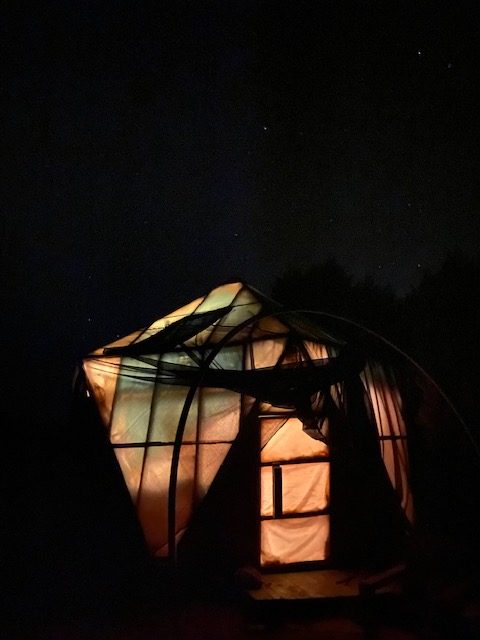


Misha, I really admire you: you are doing the right thing at the right time of your life. And I enjoyed the chicken movies so much! Good luck in everything!
Pingback: Matters of Life and Death – Wandering Mystic